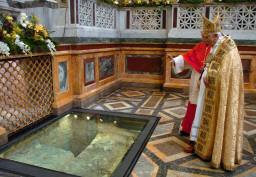A Roman tomb believed to be that of St Paul may be opened for the first time in 2000 years, the archpriest of the cathedral where it is located said Friday.
''We've been thinking of opening St Paul's sarcophagus for a while and Pope Benedict XVI has not ruled out ordering a thorough analysis of the tomb,'' said Cardinal Andrea Cordero Lanza di Montezemolo of St Paul's Outside the Walls.
''We've also studied how we could do it. You have to bear in mind that this sarcophagus has been there for 20 centuries and has never been opened,'' he said.
''Opening it would be a major job, given that the tomb is enormous and it would mean we'd have to demolish the papal altar.
Vatican archaeologists uncovered the tomb in 2006 in a crypt under the basilica and said the fact that it was positioned exactly underneath the epigraph 'Paulo Apostolo Mart' (Paul the Apostle and Martyr) at the base of the cathedral's main altar was conclusive proof that it was the apostle's sarcophagus.
The tomb also has a hole in the top through which which pieces of cloth could be pushed, touching the relic and becoming holy in their turn.
However, nobody actually knows what is inside the tomb, which may even be a cenotaph (empty tomb) erected in the name of the saint.
Cordero Lanza di Montezemolo said past attempts to enter the tomb using sophisticated microcamera technology had failed because of its 25-centimetre-thick walls.
St Paul's Outside the Walls is located about three kilometres outside the ancient walls of Rome and is the largest church in the city after St Peter's.
Paul was a Roman Jew, born in Tarsus in modern-day Turkey, who started out persecuting Christians but later became possibly the greatest shaper of the Church.
He did not know Jesus in life but converted to Christianity after seeing a shining light on the road to Damascus.
The saint, who called himself the Apostle to the Gentiles, was a great traveller, visiting Cyprus, Asia Minor, mainland Greece, Crete, and Rome bringing the gospel of Jesus.
His 14 letters are largely written to churches which he had founded or visited.
They tell Christians what they should believe and how they should live but do not say much about Jesus' life and teachings.
Paul's influence on Christian thinking has, arguably, been more significant than any other single New Testament author.
His works were hugely influential on some of the great Christian thinkers and leaders of movements, including St Augustine and Martin Luther.
They have also been criticised by feminist writers for assigning women a subordinate role in the Church.
Paul is believed to have been executed for his beliefs around AD 65.
He is thought to have been beheaded, rather than crucified, because he was a Roman citizen.
According to Christian tradition, his body was buried in a vineyard by a Roman woman and a shrine grew up there before Emperor Constantine consecrated a basilica in 324.
The basilica was enlarged and restored over the centuries but had to be rebuilt in the 19th century after it was destroyed in a fire.
St Paul is the patron saint of Malta and the City of London and has also had several cities named in his honour including Sao Paulo, Brazil, and Saint Paul, Minnesota.













